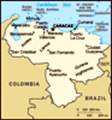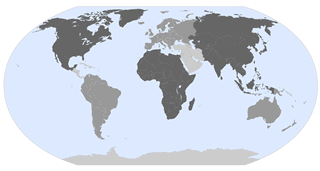Advertisement
Published: July 31st 2012
Hello everybody,
this is my last blog from my 4-week trip to Venezuela.
I left Merida by nightbus towards Valencia. The journey was long and tiring. In the morning I arrived in Valencia. In Valencia I have several friends who I actually know through the internet (penfriends) since 1999 / 2000 and I kept in contact with them until today. Facebook helped a lot to maintain these friendships.
Valencia is the third largest city of Venezuela with about two million people. It's also the capital city of Carabobo state. The city is quite big and it has a lot of industries in its outskirts. The current metro-system consists of one line with 7 stations and there are more stations in construction. A ride in the metro is cheap (Bs. 1). The city also has a small, historical center with, of course, the Plaza Bolivar. At the Plaza Bolivar you find the cathedral as well, and also the "Centro de artes Alexis Mujica". Here they hold different expositions and when I was there, they had the expo called "La Fuerza del Petroleo" (the power of petrol). This expo gave a good and interesting view through the history
of oil discovery and exploitation in Venezuela. Not very far from there I visited "Casa de Páez". Jose Antonio Paez was a general of the army which fought against Spain, and he president of Venezuela in three occasions during the 1800's. The avenida Constitución, starting at Plaza Bolivar, is a long, colourful street only for pedestrians and it's filled with shops, snackbars etc.....it's always busy! At the other end of this streets you'll find the metro-station Cedeño. At Plaza Bolivar I met with one of my friends, Sikleb, and her cousin. We just sat there and talk for more than one hour. Here I met also with Maryelis and she took me for a little walk in town, showed me and told me a lot, we had lunch together too and we ended up in the huge Metropolis Mall. With Raul, another friend, I took a walk through town as well and through the Fernando Peñalver Park. It's a big, nice and well maintained park north of the city centre.
With Aldo, another friend, I went to Campo Carabobo, which lies outside of the city towards the southwest. At this park the Carabobo Battle took place, which led Venezuela (then
Gran Colombia) to its independence. The park is big and very well maintained with many palm trees, and a wide avenue leading towards the arch. I was lucky enough to be there just when there was a small military march going on. Behind the arch there is a big altar with Simon Bolivar's statue on the top.
Aldo also took me for a short visit to
Puerto Cabello, it lies at the Caribbean coast north of Valencia. The city has approximately 300.000 people and the most important harbour of Venezuela: it accounts for about 75%!o(MISSING)f the imports and exports in the country. The historic centre of the city is small but beautiful. The San Felipe Fort will immediately catch your attention, as it in front of a walkway built along the shores of the sea. Here many people like to hang around, kids run skateboards, fishermen trying the catch something for the day etc. We wanted to visit the Solano Fort up a hill, but it was closed that day (it was a Monday and on Mondays all museums etc. in Venezuela are usually closed for maintainance).
My journey continued with another 12-hour nightbus towards
Ciudad Bolivar,
capital of the Bolivar state in southeastern Venezuela. The lies on the southern shore of the Orinoco River, Venezuela's longest river. Originally named "Angostura" (Narrowness), the city was founded in mid 18th century. This name is because of the fact that it's the narrowest point of the Orinoco River. Ciudad Bolivar is also where the first bridge over the Oricinoco was built, the Angostura Bridge in late 1960's. About 6 years ago the Orinoquia Bridge was opened in Puerto Ordaz, a city about 100km east of Ciudad Bolivar, making it the second crossing over the Orinoco. The city has a tropical climate and is very warm, humid and it rains often. Ciudad Bolivar has a very beautiful historical centre which, like all the other ones, is very colourful. The historical centre here is better maintained and cleaner compared to Puerto Cabello and Valencia. Fortin el Zamuro is a small fort located at the highest point of the city. From here you see Orinoco in front, historical part of the city to your left and the rest of the city to your right and in the back. The city has about 400.000 people. Like every Venezuelan city or town, this city
also has its Plaza Bolivar. At the plaza there is the "Casa del Congreso de Angostura", interesting place to visit. In this building Simon Bolivar held Venezuela's second constitutional congress. Nearby there was the "Casa de Piar". Manuel Piar was from Curaçao and he was a soldier who also fought for Venezuela's independence. He had several victories in the region but came into conflict with Simon Bolivar, who later let them arrest him and sentence him to death by execution. At the house you could enter the room where he was kept inprisoned in October 1817. Today, the airport of Puerto Ordaz bears his name.
After one night in Ciudad Bolivar I took a 1-hour flight to
Canaima National Park. It lies towards the south of Ciudad Bolivar and Puerto Ordaz. With an area of about 30.000 square km (size of Belgium) it's Venezuela's second largest national park. In 1994 it was declared a World Heritage site by the Unesco. The plane lands at a small village with about 2000 people. Here there are several camps and lodges where you can stay. The village lies at the shores of the Canaima Lagoon with its powerful waterfalls right there: Hacha
Falls, Colondrina Falls, Wadaima Falls and Ucaima Falls...all next to each other. Once we arrived they drove us to our camp, where I got my own room with own bathroom. Before lunch I went for a walk to she shores of the Lagoon and up towards a viewpoint to the Ucaima and Golondrina Falls. After lunch we went with a boat towards the other side of the lagoon. After a 25 minute hike we got to El Sapo Falls. But one of the most spectacular things I've experienced was when we walked down a train that led us down the falls. Here there is a path that runs behind the waterfall, behind the actual "curtain". Because the stones could be very slippery, they advised us to go with socks since they grip easier on the rocks. This walk behind the waterfal was A-MA-ZING! So much water, so much power, so much noise....incredible! I had my camera in two zip-line plastic bags. At certain points you get completely wet, therefore everyone should go with their swimming clothes. In Canaima you'll always meet many other people. There were many Venezuelan's on vacation here and I spoke to many of them. Most were
impressed by the fact that I know so much about their country and that I speak Spanish well.
After this trip everyone went back to their camp. I took a shower and waited for dinner. After dinner we went to a bar in the village where they had music and people dancing. Here I saw almost everyone from our group and it was fun....the bar turned out to be much better than I expected. I stayed there until 2am.
After breakfast the next day, we took a boat again and went on the Caroní River towards the south. After 15 minutes there was a part where we had to get off, walk about half an hour on land and meet the boats again at the other side. There are many rapids in that section and they can't pass with a boat fully loaded with people. The water is not very deep there and it would be impossible to pass. After about an hour on the water we stopped at a waterfall the call "Pozo de la Alegria". The waterfall fills a "natural pool" there where we all took a swim. The next stop was lunchtime and thn we went
on. Along the whole journey there were many different "tepuys", which are table-top mountains you find all over this region of Venezuela. Some of them look very particular, with many different pilars on the top due to erosion. It took us 4 hours to reach our camp at Isla Ratón. This camp is located in front of the
Angel Falls: world's highest waterfall at 979m. This was an absolute DREAM COME TRUE for me, as I always wanted to get here one day. We walked for almost an hour through a trail that leads you to a viewing point very close to the Angel Falls. It was just "magnificent"...I can't describe it in words. There she was, tall and full of pride, spewing all that water down! We spent the night at the camp and the next morning we took the boat back to Canaima village. This time was downstream so it went much faster. Then I flew back to Ciudad Bolivar, they drove me to Puerto Ordaz airport and I flew back to Caracas. I spent my last 3 days in Caracas and I visited my cousin Antarajú a whole afternoon, the next day I went to buy some
stuff at Sabana Grande Boulevard and the huge Sambil shopping center. I also met my cousin Jean Luis in Caracas, Juan Carlos' son and Carin's grandson.
What can I say, I had a wonderful time in Venezuela! Due to the Bolivar currently pegged to the dollar at Bs4,30 it makes the country very expensive. Caracas is currently one of the most (of not the most) expensive city in Latin America. You don’t have another choice than to change cash US Dollars with people you know and they’ll give you 8,50 to 9 Bolivars for each dollar. Even this way the country still isn’t “cheap”. BUT, it’s a marvellous country with a very friendly and helpful population. Everything went well, as planned...thank God! I will be back one day to get to know other parts of this country, which actually is a part of my life!
Thanks for reading and till the next blog!
Regards,
Elton
Advertisement
Tot: 0.747s; Tpl: 0.015s; cc: 33; qc: 143; dbt: 0.2847s; 1; m:domysql w:travelblog (10.17.0.13); sld: 1;
; mem: 1.5mb

























